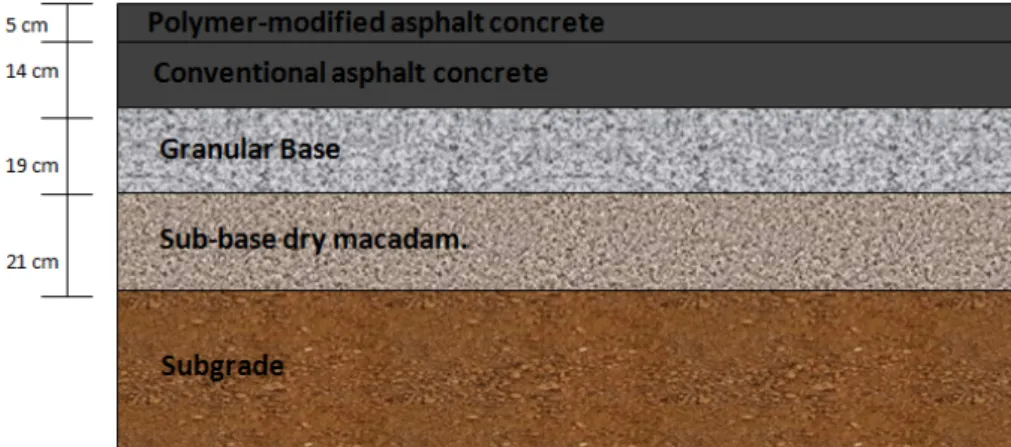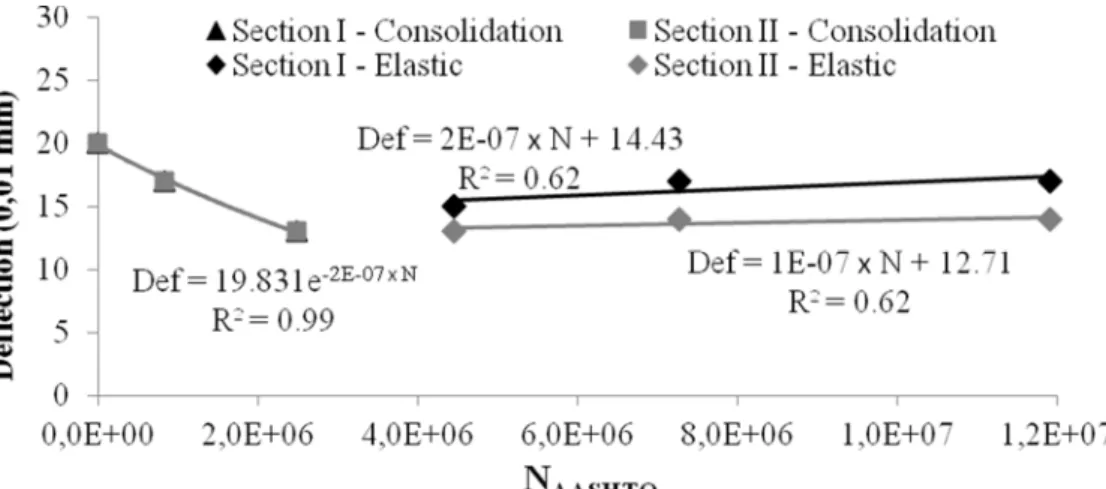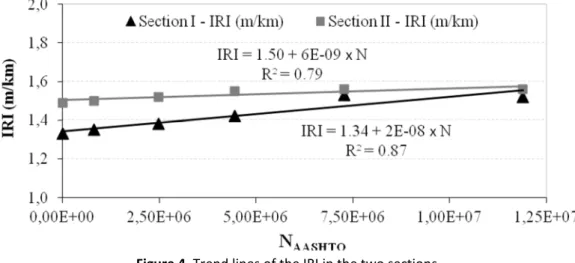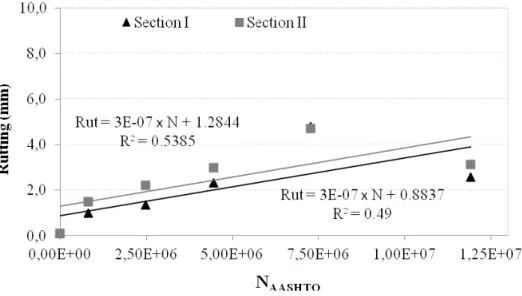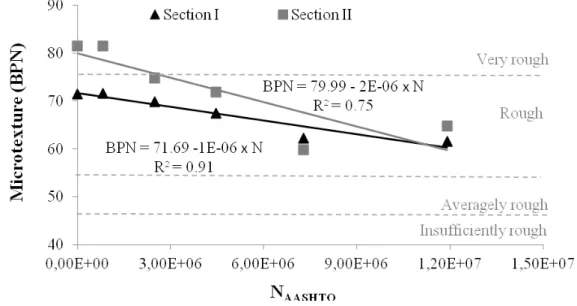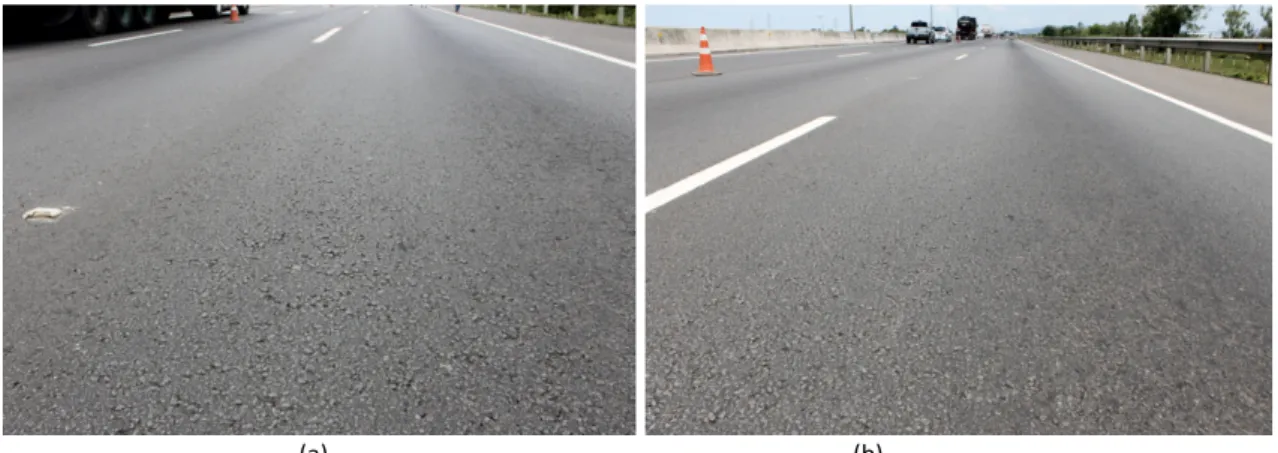Monitoring analysis of two pavement sec ons of
highway BR-448/RS included in the Asphalt Thema c
Network Project
Camila Kern1, André Luiz Bock2, Washington Peres Núñez3, Jorge Augusto Pereira Cera'4
1Universidade Federal do Rio Grande do Sul, Rio Grande do Sul, Brazil, camilakern@yahoo.com.br 2Universidade Federal do Rio Grande do Sul, Rio Grande do Sul, Brazil, andrebock.eng@gmail.com 3Universidade Federal do Rio Grande do Sul, Rio Grande do Sul, Brazil, washington.nunez@ufrgs.br 4Universidade Federal do Rio Grande do Sul, Rio Grande do Sul, Brazil, jorge.cera5@ufrgs.br
Recebido:
4 de junho de 2019
Aceito para publicação:
30 de janeiro de 2020
Publicado:
15 de maio de 2020
Editor de área:
Jorge Barbosa Soares
ABSTRACT
Highways are the mode of transport used for the transporta on of the majority of loads and passengers in Brazil; however, the lack of conserva on of pavements has caused several economical losses to the country. Only through suitable pavement management the rehabilita on measures taken might ensure a sa sfactory level of service. The pre-sent research aimed at evalua ng the performance of two pavement sec ons of the federal highway BR-448/RS, in southern Brazil. For three years, the evolu on of the pavement structural capacity and func onal condi on were followed in order to pro-pose performance trends. Deflec ons, permanent deforma ons, and surface defects surveys scarcely varied and were quite low due to the thick asphalt layers used (19 cm). On the other hand, segrega on of the asphalt mixture was observed when the final layer was laid. That segrega on affected pavement texture, reduced re-road fric on, and caused the forma on of surface water films; thus, reducing the road safety. In general, the proposed trend lines predicted quite accurately the pavement performance throughout the period evaluated and will be used in the MeDiNa soEware database for the crea on of a new Brazilian pavement design method.
Keywords: Flexible pavement, Performance monitoring, Trend lines. DOI:10.14295/transportes.v28i2.2082
1. INTRODUCTION
In Brazil, although the transportation of goods and people is predominantly done through high-ways, this mode has historically shown remarkable de iciency. The lack of conservation of the road network has caused several economic damages to the country, such as: loss of production, increase of vehicles operational cost, greater risks of accidents, among others.
According to the National Transport Confederation (2017), 57% of all the country's paved network, out of the 107.161 km surveyed in 2017, showed some kind of inadequacy in general condition, including pavement, road signs and track geometry. Regarding exclusively
pavements, nearly 51% of the road length presented some type of more severe defects; thus, having their Present Serviceability Rating (PSR) classi ied as fair, poor or very poor.
The poor quality of highways re lects a history of low investment in the sector, which received a federal investment of only 0.14% of the GDP (CNT, 2017) in transport infrastructure in 2017. For the past 30 years, the quality of Brazilian pavements has decreased due to the increasing traf ic volume, climatic and environmental changes, inadequate pavement maintenance, and other factors (Soncim, 2011; Paterson, 1987; Haas et al., 1994; Yoder e Witczak, 1975).
In addition, the old national empirical method of asphalt pavement design no longer matches the pavement needs due to the signi icant increase in commercial traf ic and the evolution of vehicles. Nowadays, the availability of more advanced tools (relevant laboratory tests and soft-wares for mechanistic-empirical design) must also be considered. Such scenario has supported a national effort to develop a new Brazilian lexible pavement design method, which began in 2009 through the Asphalt Thematic Network – RTA (a partnership among PETROBRAS and sev-eral universities in Brazil).
One of the irst actions of the RTA was to promote standardized follow-up of experimental sections, which are monitored by universities, designed in partnership with road agencies and concessionaires. The objective was to collect systematic data on national pavement behavior, the main gap for the construction of a more modern design method (Santiago e Soares, 2015). Thus, since its inception, several universities have been conducting systematic surveys of func-tional and structural performance data of typical nafunc-tional pavements on the various section monitored by RTA in Brazil. In the state of Rio Grande do Sul, research studies of the Federal University (UFRGS) have monitored test sections built on two federal highways (BR-290/RS and BR-448/RS), evaluating functional, structural, and safety aspects.
In this context, this paper reports and analyzes the performance of two test sections on the BR-448/RS highway, considering functional, structural, and safety aspects in order to contribute to the MeDiNa software database for the development of this new method lexible pavement design.
2. BACKGROUND
According to AASHTO (1990), pavement performance is related to the ability of the pavement to accomplish its objectives over time. In order to predict this performance, the Restoration Pavement Manual - IPR-720 (2006b) states that it is necessary to quantify the reduction of util-ity or generation of defects over the life of the pavement through periodic evaluations.
By pavement evaluation it is possible to check whether the pavement needs maintenance or reconstruction, if it has been well constructed or if it meets the speci ications for which it was designed. Pavement evaluation is a set of activities that aim to describe qualitatively and quan-titatively the condition of pavements (Péres, 2016). There are two types of pavement evaluation to verify its performance: the functional evaluation used to assess comfort and safety; and the structural evaluation, to assess the quality of the pavement to withstand vehicle loads without exceeding the carrying capacity of the structure.
The functional evaluation describes the pavement performance for rolling quality and safety from the user's point of view. It is usually determined by measuring surface defects, longitudinal irregularities, and macro- and microtextures (tire-road friction). Structural evaluation, how-ever, encompasses the complete characterization of the pavement structural elements and var-iables. It provides an objective description of its behavior as a function of traf ic loads and
environmental factors, as well as determines coating quality indicators and the integrity of the underlying material layers (Balbo, 2007). Structural evaluation is usually done by measuring of wheel path depressions and de lections.
The present and future evaluation of pavement performance involves techniques to obtain parameters of performance in the ield, knowledge of the behavior expected for each type of pavement, and use of mathematical models that make it possible to portray the pavement be-havior over time (Albuquerque, 2007).
Pavement performance is closely linked to its deterioration mechanisms. In this way, it is important to point out that the main factors that contribute to the beginning and propagation of deterioration are climatic factors, traf ic demands, functional and structural behavior, physi-cal and chemiphysi-cal characteristics of building materials, and pavement age (Soncim, 2011; Pater-son, 1987). Thus, for the development of a rational method of designing lexible pavements, it is essential to establish design criteria based on adequate performance prediction models.
Performance prediction models for predicting pavement deterioration can be found in the literature (Péres, 2016; Balbo, 2007; Santiago e Soares, 2015; Ferreira, 2016; Santos, 2015; Soa-res et al., 2009; Khaled, 2004; Rosa et al., 2017; Solazzo et al., 2017; Mahmood et al., 2016). Being able to predict pavement behavior is an essential factor for the effective application of any rehabilitation and management model. Performance prediction models developed in Brazil with the highest international recognition were incorporated into the HDM (Highways Design and Maintenance Standards Model), model developed by the World Bank, with some adapta-tions (Paterson, 1987; Queiroz, 1981). Nationally, the research carried out by Marcon (1996), Yshiba (2003), Benevides (2006), and Albuquerque (2007) stand out when it comes to irregu-larities, permanent deformations, and de lections.
In southern Brazil, the performance models proposed by Mattos (2009), Victorino (2008), and Vitorello (2008) present good results. Finally, the trend lines presented for the highways monitored by UFRGS (Bock, 2016; Kern, 2017; Mattos, 2014) help in understanding highway performance in the region.
Since the creation of the Asphalt Thematic Network, research projects carried out in various regions of the country have presented pavement response data that contribute to the under-standing of the behavior of the materials used to form its layers (Balbo, 2007; Santiago e Soares, 2015; Ferreira, 2016; Santos, 2015; Soares et al., 2009). This joint action helps enrich the na-tional database and the decision-making regarding the choice of the type/material to be used in the design.
3. METHODOLOGY
The highway BR-448/RS is located near the metropolitan area of Porto Alegre, in the state of Rio Grande do Sul, and is 23 km long. It was inished in December 2013 and since then two sections have been monitored. Section I is located between km 15+600 and km 15+900 and Section II is located between km 16+760 and km 17+060. The monitoring of the construction of the experimental sections and the analyses of the materials used are presented in Bock (2016).
The two experimental sections were de ined according to the geotechnical design solutions adopted. In Section I, vertical drains were implanted to consolidate soils of the subgrade. In Section II, soft soil removal and replacement by sandy soil was performed; thus, forming a drain-age mattress. The highway structure has a ive-centimeter layer of polymer-modi ied asphalt
concrete (range B), 14 cm of conventional asphalt concrete (range B), in accordance with DNIT (2006a), 19 cm of granular base, and 21 cm of sub-base dry macadam. The structure of the highway is shown in FIGURE 1.
Figure 1. Structure of the highway BR-448/RS
The activities developed to evaluate the studied sections consisted of monitoring the evolu-tion of funcevolu-tional parameters and structural performance. The results correspond to the irst years of traf ic, from December 20, 2013, when the highway was opened to traf ic, to December 15, 2016, date of the last monitoring. TABLE 1 shows the dates of the monitoring carried out together and their respective traf ic estimates (NAASHTO).
Table 1 – Dates of monitoring
Date Monitoring Traffic
December 15, 2013 0 months 0.00E+00 March 08, 2014 3 months 8.22E+05 September 27, 2014 9 months 2.48E+06 April 18, 2015 16 months 4.45E+06 January 23, 2016 25 months 7.27E+06 December 17, 2016 36 months 1.19E+07
3.1. Field Tests
The structural evaluation of the pavement was performed with the measurement of de lections using the Falling Weight De lectometer (FWD), following the DNER-PRO 273 standard (1996). The choice of equipment was due to the presence of de lections closer to those that would be caused by a real dynamic load. The FWD simulates the passage of a wheel over the pavement by dropping a set of masses from a certain height onto a shock absorber system capable of trans-mitting a load pulse similar to the shape of a sinusoid to the pavement. The load is transmitted to the pavement through a thirty-centimeter diameter plate and is measured through a load cell. The recoverable displacements generated on the pavement surface are measured by 7 geo-phones (velocity transducers). In the surveys conducted for this paper, distant geogeo-phones were used: with 0, 20, 30, 45, 65, 90, 120 cm from the center of loading. The comfort conditions were evaluated by measuring the irregularity associated with the road, determining the International Roughness Index (IRI). The evaluation of the longitudinal irregularity was established by the DNER-PRO 182 standard (1994) and using an Inertial Laser Pro iler.
The IRI was determined by measuring both longitudinal pro ile wheel path depressions with laser sensors installed at the front of a vehicle. In addition to these sensors, the equipment con-sists of accelerometers and an inertial motion sensor.
The permanent deformations were measured according to the DNIT-PRO 006 (2003b) pro-cedure, which determines the use of a standard aluminum framework with a length of 1.20 m at the base and itted with a movable ruler. This ruler allows the measurement of the wheel path depressions in millimeters. Permanent deformations of the inner wheel path (IWP) and the outer wheel path (OWP) were measured in millimeters at each stake of the monitored sections. In each of the points, the maximum depression was assessed.
In order to evaluate the tire-road friction, the macro and the microtexture of the pavement were veri ied. The Sand Patch Test, standardized by ASTM E 965 (2006), was used to determine the roughness of the pavement. This test allows the determination of the macrotexture of the pavement through the height of the sand patch, or in French Hauteur au Sable (HS). The Sand Patch test consists of spreading a certain volume of ine calibrated sand over the surface of the pavement using a rubber-based disc. The sand is gradually spread in circular motions until the sand path cannot be further increased. The diameter of the path is measured and, since the initial sand volume is known, it is possible to calculate the average thickness of the sand patch. The resulting sand height is expressed in mm. The macrotexture classi ication of a surface is also speci ied in the Rehabilitation Manual for Asphalt Pavements (2006b) and its boundaries are de ined as a function of the average sand patch height (HS), which is advised to vary between 0.6<HS<1.2 mm. Surfaces should have average or thick texture. According to Brosseaud (2006), acceptable macrotexture values for acceptable adhesion would be between 0.4 mm and 0.7mm to ensure good surface drainage.
The British Pendulum, standardized by ASTM E303 (2013), was used to check the microtex-ture. It determines the surface slip resistance by simulating the passing of a low speed vehicle tire on a wet pavement with the measured friction value expressed in BPN (British Pendulum Number). The microtexture of a surface is classi ied according to the test and speci ied in the Rehabilitation Manual for Asphalt Pavements (2006b), which recommends BPN values ≥ 55 and that surfaces should have rough to very rough characteristics.
The survey of defects followed the identi ication guidelines established by the DNIT-TER 005 standard (2003a). An objective evaluation of the surface of the pavement was carried out ac-cording to the DNIT-PRO 006 standard (2003b) to establish the Global Severity Index (GSI). The Global Severity Index is a numerical value obtained through the evaluation of defects on the surface of lexible pavements which aims to re lect the state of the pavement. It is classi ied according to the concepts presented in TABLE 2.
Table 2 – Concepts of pavement degradation according to the GSI Concept Limits
Excellent 0 < GSI ≤ 20 Good 20 < GSI ≤ 40 Fair 40 < GSI ≤ 80 Poor 80 < GSI ≤ 160 Very poor GSI > 160
4. RESULTS
4.1. Deflec@ons (FWD)
Structural evaluation is an important parameter that veri ies the evolution of de lections on the top of the pavement due to traf ic. FIGURE 2 shows the trend lines of the maximum de lections of each section after being corrected according to the temperature.
Figure 2. Trend lines of the deflections measured in the two sections
The maximum de lection values obtained were low (close to common values for concrete pavements), which may be related to the robustness of the pavement structure, which has a nineteen-centimeter thick coating layer. It was possible to observe a very similar evolution of the de lection through time for the two sections. In the irst months after being opened to traf ic, there was a strong reduction of de lections, which corresponds to consolidation due to traf ic. The values of de lections obtained in the initial six months (pavement consolidation) were the same for both sections, resulting in the same trend line. Only after traf ic of 2.48x106, Section I
began to present de lections greater than Section II, entering the elastic phase.
This initial consolidation stage and the elastic phase stage are common on asphalt pave-ments, as seen in FIGURA 3 (DNER-PRO 011, 1979).
Regarding the last monitoring, there was already a tendency to increase in de lections, which indicates that the pavement will enter the fatigue phase with time.
4.2. Longitudinal Irregularity
The International Roughness Index (IRI) of BR-448/RS highway was also evaluated, and is pre-sented through trend lines in FIGURE 4.
Figure 4. Trend lines of the IRI in the two sections
Immediately after the construction of the highway, Section I presented a lower IRI than Sec-tion II, being 1.33 m/km and 1.49 m/km, respectively. However, by observing the evoluSec-tion of the parameter during the irst months, an approximation of the values was noticed. Section I presented a higher rate of evolution than Section II, and this factor may be associated to the different solutions adopted in the subgrade of each section. Currently, the two sections have IRI values of 1.56 m/km (Section I) and 1.52 m/km (Section II).
According to Bock (2016), the executive project of this highway speci ies that the top layer of the pavement should have a maximum IRI of 2.5 m/km. IRI values above 2.5m/km indicate that the section needs maintenance to avoid accidents. According to the Asphalt Pavements Rehabilitation Manual (2006b), pavements with IRI values lower than 2 m/km are considered excellent.
4.3. Wheel Path Depressions
Permanent deformation is an important parameter for the safety of road users. Depression limits depend on the road width and slope, where the greater the road width, the greater the slope and the permissible wheel road depth. The evolution of the permanent deformation of the two sections can be seen in FIGURE 5.
As traf ic demand increased, deformations increased gradually, with maximum values of 4.8mm. In the last survey (36th month) a decrease in deformation was observed for the two sections. According to the Asphalt Pavements Rehabilitation Manual (2006b), rutting values greater than 120mm are indicative of structural compromise of the pavement, which, thus, re-quires intervention.
This result was not expected as normally with increasing traf ic, measured rutting values tend to gradually increase or stabilize. Such a result can be attributed to the use of the standard
aluminum framework, which measures only the selected arrow, and to some operator subjec-tivity when selecting the exact location for arrow measurement on the wheel path (Bastos et al., 2015). Another hypothesis is the difference in pavement temperature at the time of collection.
Figure 5. Trend lines of the evolution of the rutting
4.4. Tire-road Fric@on
The data collected from the wheel path for the evaluation of the macro- (Sand Patch Test) and micro-textures (mean BPN value) are presented in trend lines in FIGURE 6 and FIGURE 7.
Figure 7. Trend lines for the evolution of microtexture.
Considering the macrotexture of the pavement, during the irst two years of monitoring there was a marked drop in the condition of the texture, which went from an average to a ine condi-tion. In the last inspection, an increase in the macrotexture of the pavement was observed, which was again classi ied as average.
In relation to the microtexture, initially the mean values in Section II were signi icantly higher than in Section I. Section II, which presented a very rough surface until traf ic of 2.48x106, soon
passed to a rough surface. Section I presented from the beginning a decreasing rate lower than that of Section II.
A high loss of texture in the irst monitoring can also be explained by the fact that the aggre-gate lost the asphalt binder ilm that covered it and started to suffer wear due to traf ic demand (Kern, 2017). This aspect was veri ied in both monitored sections. Furthermore, the quality of the execution of the asphalt mixture was not satisfactory, presenting segregation in both sec-tions (Bock, 2016).
This increase in macro and microtexture values in the last survey may come from several factors, such as:
• The pavement and air temperature were not taken into account at the time of the test, and the general trend shows skid resistance values being higher in autumn and winter and lower during spring and summer (Wilson e Dunn, 2005). This variability of tire-road friction grip over the year can reach approximately 30% of the average value. However, there is no general agreement on the magnitude of these effects (TNZ, 2002; Vaiana et al., 2012; Masad et al., 2009);
• The high variation of the values collected at the reading points of the sections, that is, some points presented different wear on the pavement surface. This factor was also veri ied by Santos (2015);
• The veri ication of a higher incidence of aggregate tearing in the last survey, which may contribute to the texture variations found in some places.
4.5. Surface Defects
In the two monitored sections, visual defect surveys were performed to determine the onset of pathologies from the beginning of the monitoring. As previously reported, an apparent segre-gation of the asphalt mixture applied on the road was observed after road construction, which generated a non-homogeneous quality of the bearing surface.
Excessive segregation of the asphalt mixture can adversely affect the performance of the coating in two different ways: it may be more closed, compromising safety with reduced friction for braking; or it may be more open, favoring the accumulation of water. The latter, along with the application of loading of commercial vehicles, will lead to premature degradation of the coating. The different coating surface inishes of the two evaluated sections can be seen in FIGURE 8, being more open (a) and more closed (b).
(a) (b)
Figure 8. Differences in finishing of the bearing surface due to the segregation of the asphalt mixture during the
execu-tion process
During the three years of monitoring, no critical defects were observed, only surface wearing (affecting roughness), aggregate tearing, and bleeding. The Global Severity Index (GSI) con irms this low incidence of defects. Section I obtained a GSI of 15.3 and Section II a GSI of 12.6, being the pavement of the two monitored sections classi ied as excellent. FIGURE 9 shows the current surface appearance of the two monitored sections, Section I (a) and Section II (b), after 36 months.
(a) (b)
5. CONCLUSIONS
The surveys carried out in three years on the BR-448/RS highway allowed us to follow the evo-lution of pavement degradations, making the evaluation of its performance possible. The measured de lections scarcely varied from the beginning of the traf ic loads between (20x10-2mm and 14x10-2mm) up to this date. In the same way, IRI and permanent deformation
values were also low, as speci ied by current standards.
Signi icant segregation of the asphalt mixture was observed when the inal layer was laid, which later affected the pavement texture, reducing tire-road friction. The macrotexture of Sec-tion II, initially classi ied as average (HS = 0.64mm), reached the texture limits of ine (HS = 0.4mm) after NAASHTO equal to 3x106 (only 10 months of traf ic). In comparison, in Section I that
limit was reached later (after 16 months), after traf ic accumulation NAASHTO of 4.45x106.
Simi-larly, the reduction in microtexture was also signi icant in the irst two years of traf ic. The in-crease in pavement roughness evidenced in the third year was justi ied by the presence of ag-gregate tearing, variability of the readings made, and the non-consideration of temperature var-iation. In literature, these factors were seen to affect the tire-road friction.
The data presented and analyzed in this study are helping in the development of a prelimi-nary version of the new Brazilian pavement design method, which will be done using the MeDiNa software. The data presented were entered into the software database and represent typical structures from southern Brazil. The insertion of this monitoring data will lead to the correct design of typical structures in the state of Rio Grande do Sul, which consequently improve the useful life of the pavements.
ACKNOWLEDGEMENTS
The authors thank the Pavement Laboratory of the Federal University of Rio Grande do Sul (UFRGS) and PETROBRAS for funding the research.
REFERENCES
AASHTO (1990) Guide for Design Management Systems - 1990. American Association of State Highway and Transportation Of icials, Washington DC.
Albuquerque, F. S. (2007) Sistema de gerência de pavimentos para departamentos de estradas do nordeste brasileiro. Thesis (Doctor Degree in Civil Engineering) – Post-Graduation Program of Civil Engineering, Federal University of Rio Grande do Sul. Porto Alegre, RS.
ASTM (2006) ASTM E965: Standard test method for measuring pavement macrotexture depth using a volumetric technique. American Society for Testing and Materials, West Conshohocken, PA.
ASTM (2013) ASTM E303: Standard test method for measuring surface frictional properties using the British pendulum tester. American Society for Testing and Materials, West Conshohocken, PA.
Balbo, J. T. P. (2007) Pavimentação asfáltica: materiais, projeto e restauração. Ed. O icina de Textos, São Paulo, SP.
Bastos, J. B. S.; Borges, R. L.; Soares, J. B. e Klinsky, L. M. G. (2015) Avaliação em laboratório e em campo da deformação perma-nente de pavimentos asfálticos do Ceará e de São Paulo. Revista Transportes. v.23, n 3. Rio de Janeiro. DOI:
10.14295/transportes. v23i3.914.
Benevides, S. A. S. E. (2006) Modelos de desempenho de pavimentos asfálticos para um sistema de gestão de rodovias estaduais
do Ceará.. Thesis (Doctor Degree in Civil Engineering) – COPPE/Federal University of Rio de Janeiro, Rio de Janeiro, RJ.
Bock, A. L. (2016) Pesagem em movimento de cargas atuantes em rodovias e seu impacto no desempenho de pavimentos da Rede
Temática de Asfalto. Thesis (Doctor Degree in Civil Engineering) – Post-Graduation of Program of Civil Engineering,
Federal University of Rio Grande do Sul, Porto Alegre, RS.
Brosseaud, Y. (2006) Surface properties of pavements in relation to safety and user comfort. Proceedings of the 18º Meeting of
Asphalt. Rio de Janeiro, RJ.
CNT (2017) Pesquisa CNT de Rodovias 2017 – Relatório Gerencial. National Transport Confederation. <http://pesquisarodo-vias.cnt.org.br/Paginas/relatorio-gerencial>. Accessed on October 17, 2018.
DNER (1979) DNER-PRO 011: Avaliação estrutural de pavimentos 6lexíveis. National Department Highway. Rio de Janeiro,RJ. DNER (1994) DNER-ME 182 Medição de Irregularidade de super6ície com sistemas integradores IPR/USP e maysmeter. National
DNER (1996)
DNER-ME 273: Determinação de de6lexões utilizando o de6lectômetro de impacto tipo "Falling Weight De6lectome-ter (FWD)". National Department Highway. Rio de Janeiro, RJ.
DNIT (2003a) DNIT-PRO 005: Defeitos nos pavimentos 6lexíveis e semi-rígidos. National Transport Infrastructure Department. Brası́lia, DF.
DNIT (2003b) DNIT-PRO 006: Avaliação objetiva da super6ície de pavimentos 6lexíveis e semi-rígidos. National Transport Infras-tructure Department. Brası́lia, DF.
DNIT (2006a) DNIT-ES 031: Pavimentos 6lexíveis – concreto asfáltico - especi6icação de serviço. National Transport Infrastruc-ture Department. Brası́lia, DF.
DNIT (2006b) Manual de restauração de pavimentos asfálticos - IPR 720. National Transport Infrastructure Department. Rio de Janeiro, RJ;
Ferreira, J. C. (2016) Avaliação da macrotextura de trechos pavimentados de rodovias estaduais situadas na região insular do
município de Florianópolis. Thesis (Civil Engineer Master) Department of Civil Engineering Federal University of Santa
Catarina, Florianópolis, SC.
Haas, R. C. G., Hudson W. R. e Zaniewski J. P. (1994) Modern pavement management. Krieger Publishing Company. Malabar, Florida.
Kern, C. (2017) Análise de desempenho de pavimentos da Rede Temática de Asfalto no Rio Grande do Sul – A avaliação de um
pavimento submetido à oscilação do lençol freático. Thesis (Civil Engineer Master) – Post-Graduation Program of Civil
Engi-neering. Federal University of Rio Grande do Sul, Porto Alegre, RS.
Khaled, A. A. (2004) Deterministic Performance Prediction Model for Rehabilitation and Management of Flexible Pavement.
International Journal of Pavement Engineering. v. 5, n. 2, 111-121. DOI: 10.1080/ 10298430412331286977.
Mahmood, M.; Rahman, M. e Mathavan, S. (2016) Distress based pavement performance prediction models. Proceedings of the
Eighth Intl. Conf. on Maintenance and Rehabilitation of Pavements. p. 357-368, Singapure.
DOI:10.3850/978-981-11-0449-7-052-cd.
Masad, E.; Rezali, A.; Chowdhury, A. e Harris, P. (2009) Predicting asphalt mixture skid resistance based on aggregate characte-
ristics. Texas Department of Transportation and the Federal Highway Administration. College Station, Texas.
Marcon, A. F. (1996)
Contribuição ao desenvolvimento de um sistema de gerência de pavimentos para a malha rodoviária esta-dual de Santa Catarina. Thesis (Doctor Degree in Aeronautical Infrastructure). Technological Institute of Aeronautics, São
José dos Campos, SP.
Mattos, J. R. G. (2009) Avaliação da aderência pneu-pavimento e tendências de desempenho para a rodovia BR-290/RS. Thesis (Civil Engineer Master) Post- Graduation of Program of Civil Engineering, Federal University of Rio Grande do Sul, Porto Alegre, RS.
Mattos, J. R. G. (2014) Monitoramento e análise do desempenho de pavimentos 6lexíveis da ampliação da rodovia BR-290/RS – A
implantação do Projeto Rede Temática de Asfalto no Rio Grande do Sul. Thesis (Doctor Degree in Civil Engineering) –
Post-Graduation Program of Civil Engineering, Federal University of Rio Grande do Sul, Porto Alegre, RS.
Paterson, W. D. O. (1987)
The highway design and maintenance standards model. Volume III: Road deterioration and mainte-nance effects – models for planning and management. Transportation Department of World Bank. Washington, DC.
Péres, J. S. L. (2016) Avaliação do desempenho de pavimentos 6lexíveis dos segmentos monitorados de Urubici e Itapoá. Thesis (Civil Engineer Master) Department of Civil Engineering Federal University of Santa Catarina, Florianópolis, SC. Queiroz, C.A.V. (1981) Performance Prediction Models for Pavement Manegement in Brazil. Thesis (Doctor Degree of
Philoso-phy). University of Texas, Austin, USA.
Rosa, F. D., Liu, L. e Gharaibeh, N. G. (2017) IRI Prediction Model for Use in Network-Level Pavement Management Systems.
Journal of Transportation Engineering. v. 143, n. 1. DOI: 10.1061/JPEOD X.0000003.
Soares, J.; Moreno, A. M., e Motta, L. M. G. (2009) Aspectos gerais de Métodos de Dimensionamento de Pavimentos Asfálticos de vários paı́ses e a relação com um novo método brasileiro. Revista ABPv Pavimentação, nº14, Rio de Janeiro, RJ. Solazzo, G; Fwa, T. F., e Bosurgi, G. (2017) An ANN model to correlate roughness and structural performance in asphalt
pave-ments. Construction and Building Materials. v. 134, p. 684-693. DOI: 10.1016/j.conbuildmat.2016.12.186.
Santiago, L. S. e Soares, J. B. (2015) Contribuições ao desenvolvimento do novo método de dimensionamento de pavimentos asfálticos no Brasil. Proceedings of the XXIX National Congress of Transport Research, ANPET. Ouro Preto. p. 160-171. Santos, M. S. (2015) Desenvolvimento de modelos de previsão de desempenho a partir da implantação de trechos monitorados na
região de Santa Maria - RS.. Thesis (Civil Engineer Master) Department of Civil Engineering Federal University of Santa
Maria, Santa Maria, RS.
Soncim, P. S. (2011) Desenvolvimento de modelos de previsão de desempenho de pavimentos asfálticos com base em dados da
rede de rodovias do Estado da Bahia. Thesis (Civil Engineer Master) Engineering School of São Carlos, University of São
Paulo, São Carlos, SP.
TNZ (2002) Speci6ication for Skid Resistance De6iciency Investigtion and Treatment Selection. TNZ T/10 Transit New Zeland, Wellington, New Zeland.
Vaiana, R.; Capiluppi, G. F.; Gallelli, V.; Iuele, T. e Minani, V. (2012) Pavement surface performances evolution: an experimental application. Proceedings of the 5th International Congress – Sustainability of road infrastructures. v. 53. p. 1149-1160. Italy. DOI: 10.1016/j.sbspro.2012.09.964.
Victorino, D. R. (2008) Análise de desempenho de um pavimento 6lexível da rodovia BR-290/RS solicitado por um simulador de
tráfego móvel. Thesis (Civil Engineer Master) Department of Civil Engineering Federal University of Rio Grande do Sul,
Vitorello, T. (2008)
Análise de desempenho de estrutura de pavimento 6lexível da rodovia BR-290/RS no trecho Osório-Porto Ale-gre. Thesis (Civil Engineer Master) Department of Civil Engineering Federal University of Rio Grande do Sul, Porto Alegre,
RS.
Wilson, D. J. e Dunn, R. C. M. (2005) Polishing aggregates to equilibrium Skid Resistance. Road and Transport Research. v. 14, n. 2, p. 55-71.
Yoder, E. J. e Witczak, M W. (1975) Principles of pavement design. 2ª ed. EUA: Wiley-Interscience Publication.
Yshiba, J. K. (2003) Performance model of pavements: study of highways in the state of Paraná. Thesis (Doctor Degree in Engi-neering). School of Engineering of São Carlos, University of São Paulo, São Paulo, SP.
